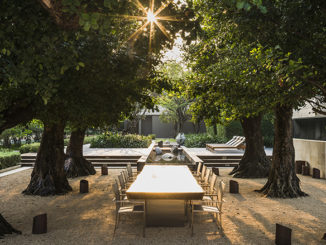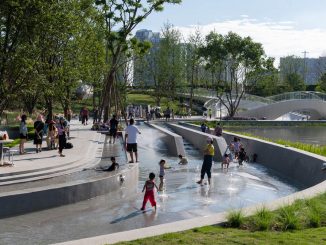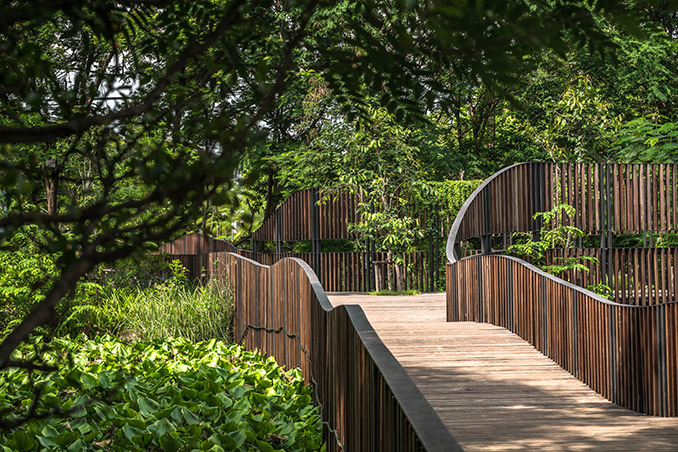
The Bird Wave Bridge, a 50 metre long pedestrian bridge crossing over small watercourse from Rotfai Park to H.M. Queen Sirikit Park at the Northern part of Bangkok aims to bridge not only the physical gaps but also the public projects’ complicated process and general perception of urban parks.
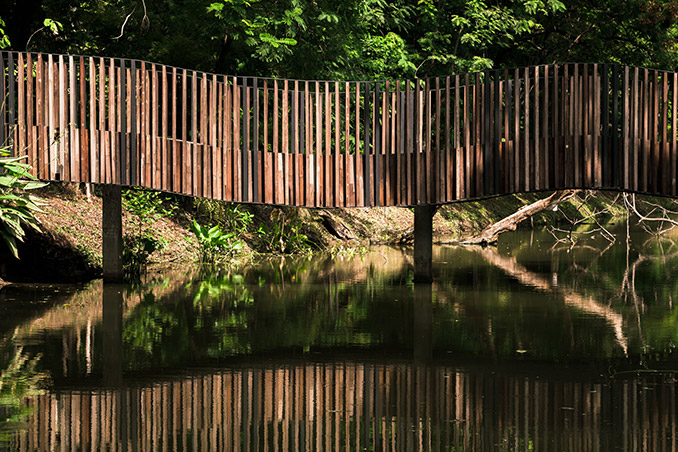
The public green area in Bangkok is only about 3 m2 per person as opposed to minimum 9m2 per person as suggested by The World Health Organization (WHO) that every city should have. The 3 m2 per person figure already compiled every green area possible from large parks to planted road median. Obviously not only the city lacks green space in terms of area but also the sizeable ones where greater capacity enables broader use and increase of urban biodiversity.
Within Chatuchak district, 3 main public parks are situated next to each other. The Rotfai Park, The H.M. Queen Sirikit Park (widely referred to as the Queen Park) and The Jatujak Park (nick name JJ Park). All the parks are under care of Public Parks Department of Bangkok Metropolitan Authority (BMA) even though the Queen Park is owned by H.M. Queen Sirikit Park Foundation. They were opened to public in 2002, 1992 and 1980 respectively. The area of 3 parks combined is 116 Hectare which will make it the biggest public park in Bangkok. Its full potential will greatly contribute to the city as Chatuchak District is set to become Bangkok’s new rail transport hub when Bangsue Grand Station opens in 2019 on the West of the Queen Park. The future urban development will see the district with more density and more need of recreation green space.
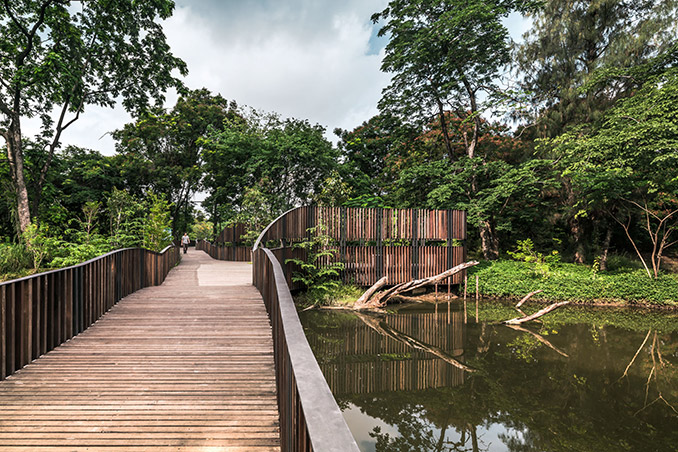
However, BMA’s master plan to combine the 3 parks since 2008 has not been realized due to the difference in land ownership resulting in the complicated inter-authority coordination, the difference in each of the parks’ concepts and programs and public concerns over the impact on existing use and cutting of trees. Users of road that cuts through these parks were also against the plan.
Currently, JJ Park, with its properly mowed open lawn suitable for leisurely activities and its location next to Mass Rail Transit as well as Underground stations, is well used throughout the week while Rotfai Park, formerly a State Railways Authority of Thailand’s golf course, is most popular during weekend for its biking route through photogenic rolling mounds.
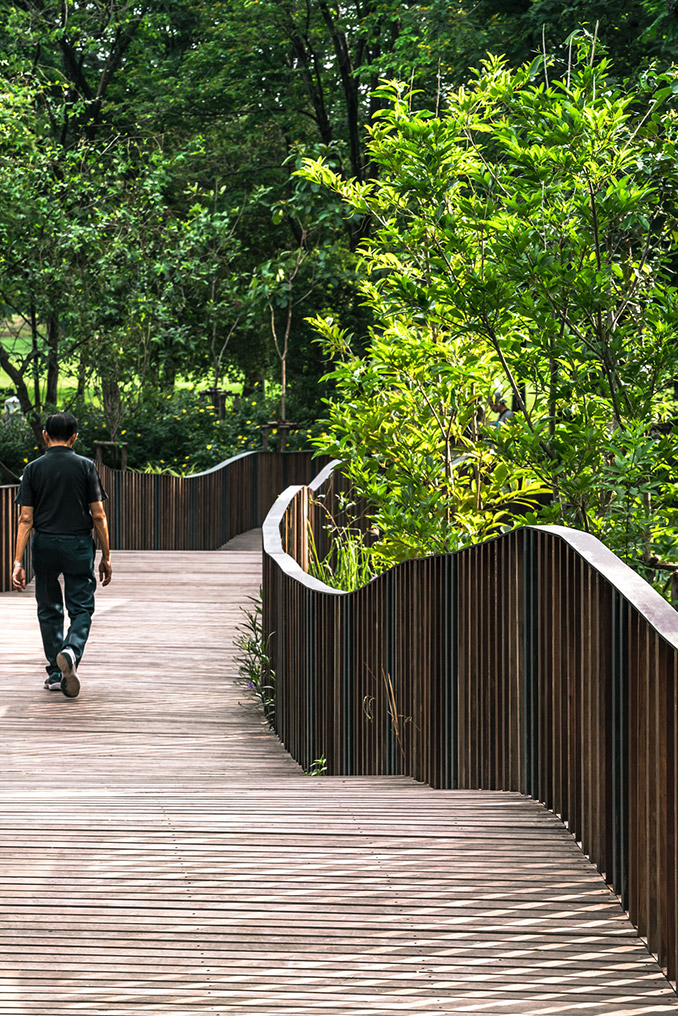
The Queen Park has the least numbers of visitors due to its less accessibility, mainly only by private transportation. It is separated from mass transit system by JJ Park and a road, and from Rotfai Park by the drainage moat. The only connection to Rotfai park was by a 1 temporary steel bridge from one corner of the Queen Park.
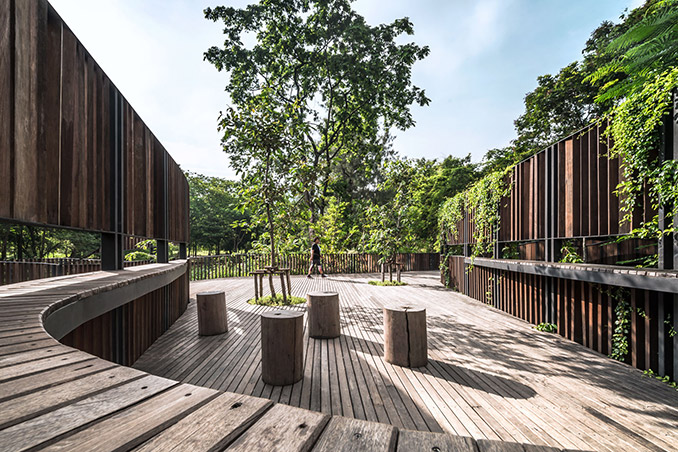
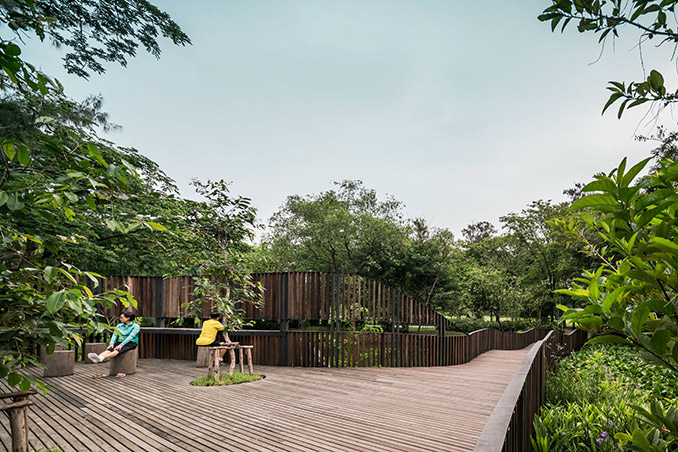
In contrary to numbers of visitors, Queen Park has the most variety of plant species among all Bangkok’s public parks as its main purpose is to collect and exhibit native vegetation from throughout Thailand. Its biodiversity also attracts most variety of birds as surveyed by The Bird Conservation Society of Thailand. The park dedicated the northeastern portion next to its boundary to Rotfai Park to be ‘Bird Sanctuary’ where vegetation is allowed to naturally grow, fallen leaves and branches are stacked to provide food and shelter for insects and dead trees are left in the moat’s shallow water for the turtles, lizards, and birds to perch. Although well known among bird watchers, the area was considered untidy or dirty by some.
It is in the south end of the Bird Sanctuary that “The Bird Wave Bridge” was proposed by the landscape architect to the director board of the Queen Park in 2014 as the ‘trial’ connection to enable real use if the 3 parks are to be joined without having to wait for the realization of the whole master plan. After 2 years of the approval process, the 60,000 USD budget for the bridge was granted by Public Parks Department and the softscape budget was funded by H.M. Queen Sirikit Park Foundation. The bridge was opened to the public in August 2016.
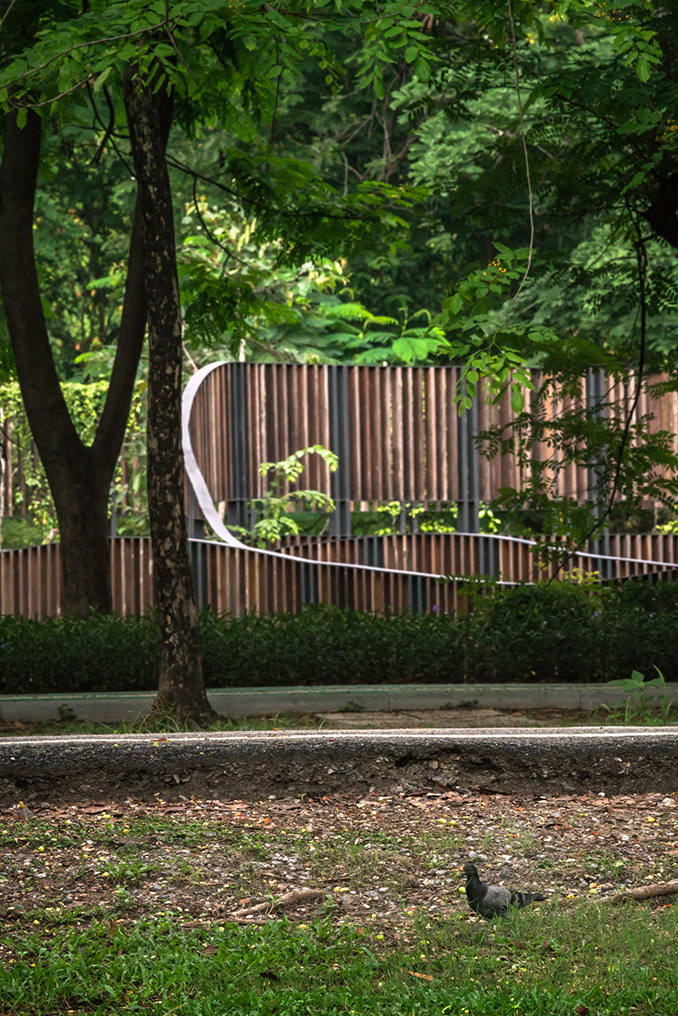
The bridge’s location is at the North end of central axis from the Queen Park and crossing over small watercourses, curving away from existing mature trees and landing in Rotfai Park at 2 m. lower elevation. The wave elevation of the bridge was employed to mitigate this level difference as well as paying homage to the traditional curved bridges in the Queen Park. The middle section of the bridge where it landed on a dike is curved out towards the Bird Sanctuary to create a room with tree crowns as roof, the semi-solid timber railing was raised around this room to form a blind with the integration of horizontal opening and wooden counter for birding activity.
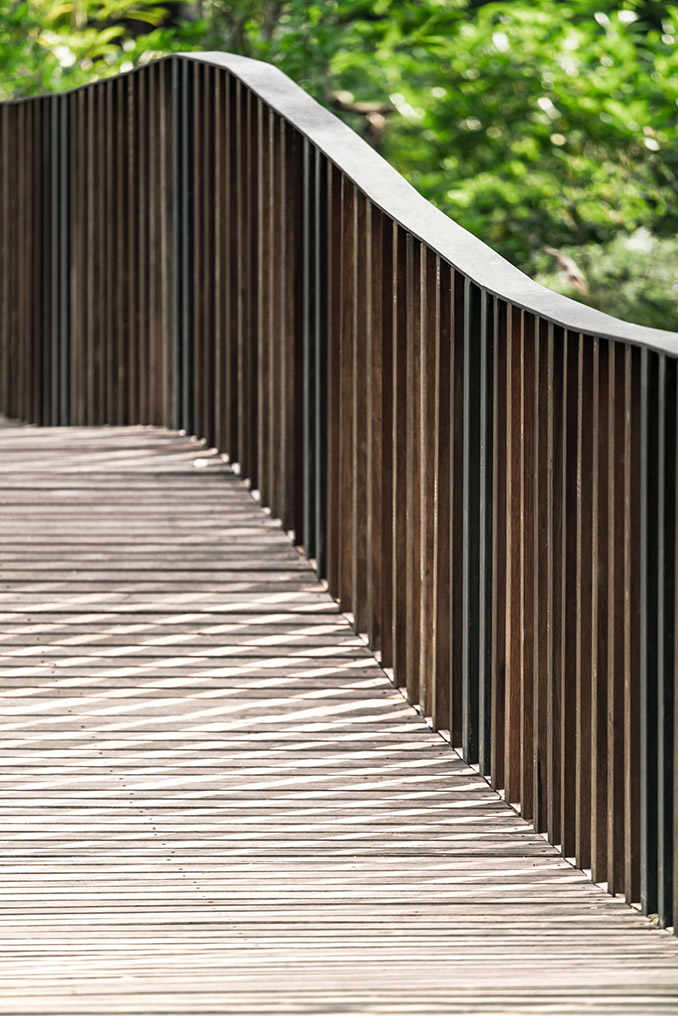
The name ‘Bird Wave’ tributes to its appearance as well as the surroundings in which it is situated, giving importance to the uses and function of the Bird Sanctuary and gently introducing the different kind of public green space where biodiversity can coexist within the urban environment.
The bridge is primarily constructed with 3 materials; reinforced concrete for the footing and column, black painted steel for above ground structure and weathered timber for flooring and railing. The surrounding landscape which was affected by construction was redesigned in consultation with The Bird Conservation Society of Thailand to increase suitable living condition for small animals, banks were gently sloped into the water to provide feeding and refuging environment and various flowering shrubs and trees were planted to protect slope and attract insects. The next step to fully complete the project is fundraising to provide interpretive signage.
Even though the bridge is achieving its purpose to connect 2 parks and attract more users, but only time will tell whether or not its humble goals to bring to public’s attention the other possible forms of public parks and to convey the idea of direct solution approach to the complicated public projects can be reached.
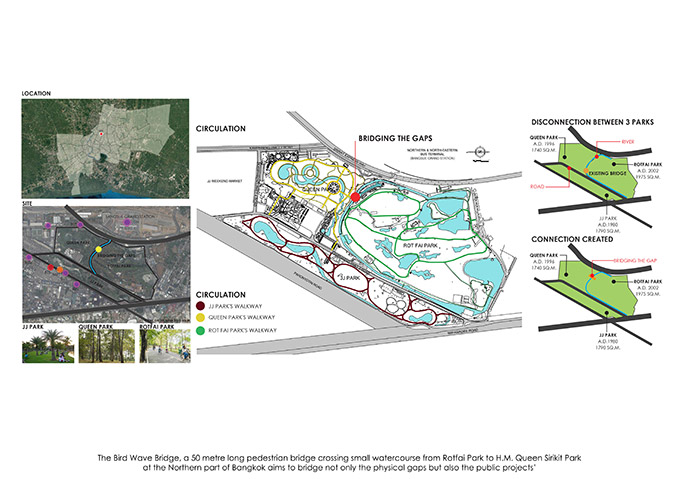
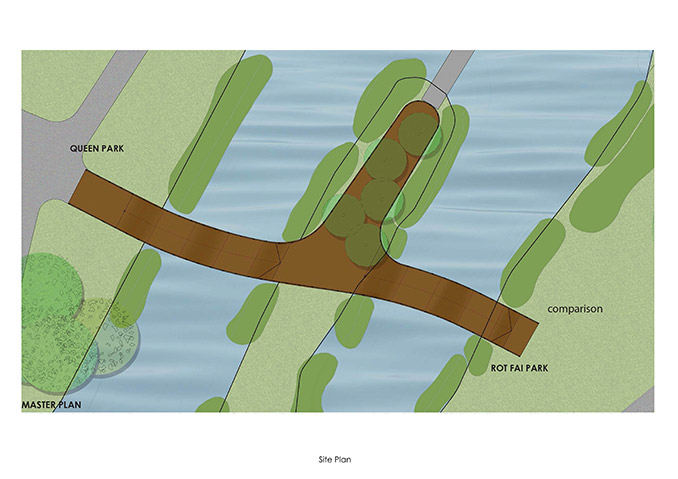
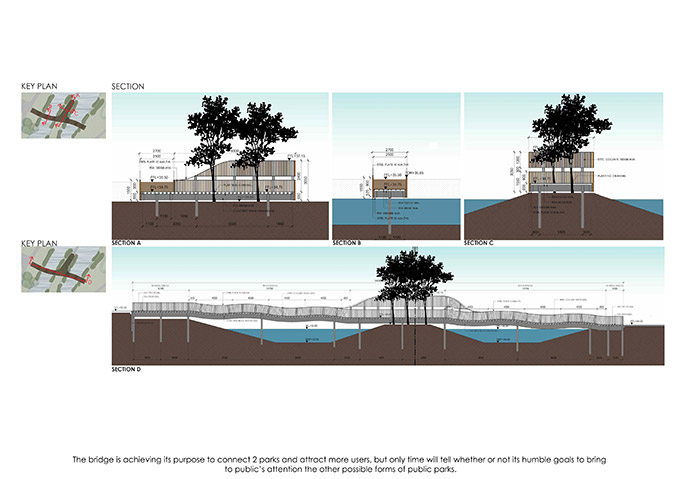
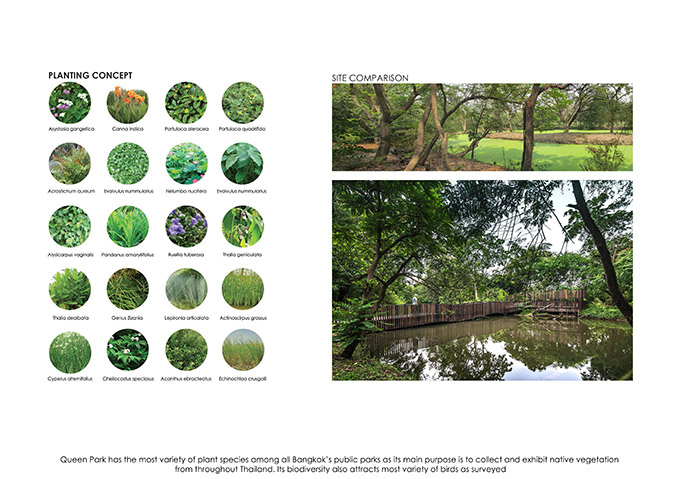
Bridging the Gaps
Landscape Architect | Shma Company Limited
Project Team |
Design Director – Namchai Saensupha
Landscape Architect – Shma Company Limited
Client & Developer | H.M. Queen Sirikit Park Foundation (Public Parks Department)
Architect | Crown Property Bureau
M&E | Crown Property Bureau
C&S Engineering | Crown Property Bureau
Completion Year | 2016
Photography Credit | Mr. Wison Tungthunya

